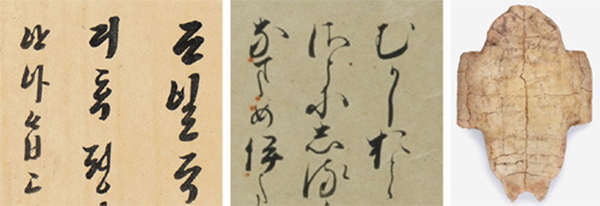An exhibition of calligraphy of Korea, China, Japan held in Seoul
The three East Asian countries, Korea, China and Japan were all historically influenced by the use of Literary Chinese, and have developed their own unique style of calligraphy from old times. Korea invented Hangeul, the Korean alphabet, and Japan came up with Kana, syllabic Japanese scripts, to create distinctive calligraphy styles.
“Joint Exhibition: Calligraphy in China-Japan-Korea,” currently being held at the National Hangeul Museum in Yongsan District, Seoul, provides a glimpse into the different calligraphy of the three countries through the exhibition of rare and valuable old books.
The delicate replica of the inscribed oracle bones owned by the Yinxu Museum of China is clearly in the form of turtle plastron with the writing on it. Dating back to 1300 B.C., characters on the bones, which would be the original form of Chinese characters, seem to be some complicated marks. Topics such as tribute, warfare, hunting and illness were usually carved on the surface, according to Chinese scholars.
In the Japan section, “Tales of Ise” catches the attention of visitors. Written in 1527, the collection of poems and associated narratives has a format similar with that of today’s novels, and includes a variety of stories, one of which illustrates a man tearing the part of clothes he is wearing to write a poem on it for a beautiful lady. As the narratives are romantic, writing also tends to be broad and bold while the variation of strokes is striking.
Also attention-grabbing is a letter handwritten in Hangeul by King Jeongjo of the Joseon Dynasty to his aunt in 1798. Calling himself “your nephew,” the future King Jeongjo kindly asks about the health and well-being of his aunt in the letter. His neat handwriting seems to explain the personality of an iron-willed king with strong determination. Early examples of Hangeul can also be found at the Hunminjeongeum Eonhaebon, a document describing an entirely new and native script for the Korean language, and Worinseokbo, which consists of two works on Buddhism. The calligraphy from an old novel manuscript, which looks like the random scribbles of children, is also impressive.
The museum took extra care by placing detailed explanation for exhibits in a separate e-monitor so that visitors can enjoy the calligraphy without any distraction. The exhibition will continue until Jan. 21 next year.
 An exhibition of calligraphy of Korea, China, Japan held in Seoul
An exhibition of calligraphy of Korea, China, Japan held in SeoulSource: english.donga.com



